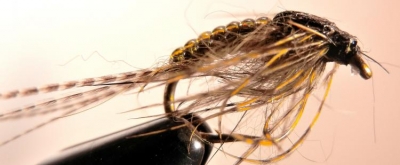
On The Fly
May 2013
"Fly tying is a school from which we never graduate"
TYING NEWS
The Southern Oregon Fly Tyers invite you to attend their meetings the second Tuesday
of each month. The next meeting is May 14, 2013. The meetings start at 6:00 PM, at the Madrone Hill Mobile
Home Park community building near Gold Hill. Bring a friend, come early so you don't miss anything, and
stay late. Tyers need not be experienced, and those with all levels of skill are welcome. Each meeting a
member is encouraged to demonstrate a new or different skill, from simple to difficult. For more
information, call Dan Kellogg at 773-4724.
Jay Daley will demonstrate two of his colorful creations:
Gut Bomb Blood Worm
Stretch Magic Midge
Jay learned to tie this fly from Bob Wolfe at the International FFF Show in Spokane last year.
DIRECTIONS: Take Gold Hill Exit #40, off of I-5 and go west, toward Jacksonville, 1.3
miles, until you reach the brick entrance way to the Madrone Hill Mobile Home Park on the right. You’ll
pass a golf course parking lot on your left shortly after leaving the freeway. After you turn right into
the mobile home park, proceed to the community building which is located about 100 yards ahead on the left.
The address is 8401 Old Stage Rd. Please park your vehicle on the bare dirt in the parking lot to avoid the
wooden septic covers in the grass.
 PATTERN OF THE MONTH – Swimming Blue Winged Nymph
PATTERN OF THE MONTH – Swimming Blue Winged Nymph
Hook: TMC 2457 #12-16
Tail: Bronze Mallard
Abdomen: Gold Holographic Tinsel
Abdomen: clear V-Rib
Legs: Dyed Olive Partridge
Thorax: SLF squirrel
Wing case: Black HT braid.
Tying Instructions:
1. Tie in bronze Mallard Tail (Few Fibers)
2. wind abdomen with Gold Halo tinsel then clear v-rib.
3. Tie in Black HT Braid for wing Case
4. Tie in Partridge hackle for legs
5. Dub Thorax with Squirrel
6. Pull over wing case and tie off.
7. Form head and whip finish.
The Blue-winged olive nymphs are members of the Baetidae family. They are free swimmers. They vary in color from dark brown to light olive or emerald. All of them are slim, minnow like nymphs. They are classified as swimmer nymphs.
Blue-winged Olive nymphs exist in all types of trout streams and are one of the most plentiful species of aquatic insects. Most are species of the baetis genus. There are several slightly different species that hatch at various times throughout the year. Blue-winged Olives are all slim, narrow profiled, swimming nymphs that act more like minnows than the crawler or clinger nymphs.
Blue-winged Olives can exist and feed in streams with plenty of current. They can cling tightly to rocks and the stems of plants when they feed in current. They use an up and down motion of their abdomen and tail to swim.
The nymphs emerge in the surface skim but the trout will eat them well before they emerge and below the surface as they rise to the surface to hatch. If the water is very cold, in the low forties for example, it may be the only way the trout will eat them. They may not take the emergers on the surface.